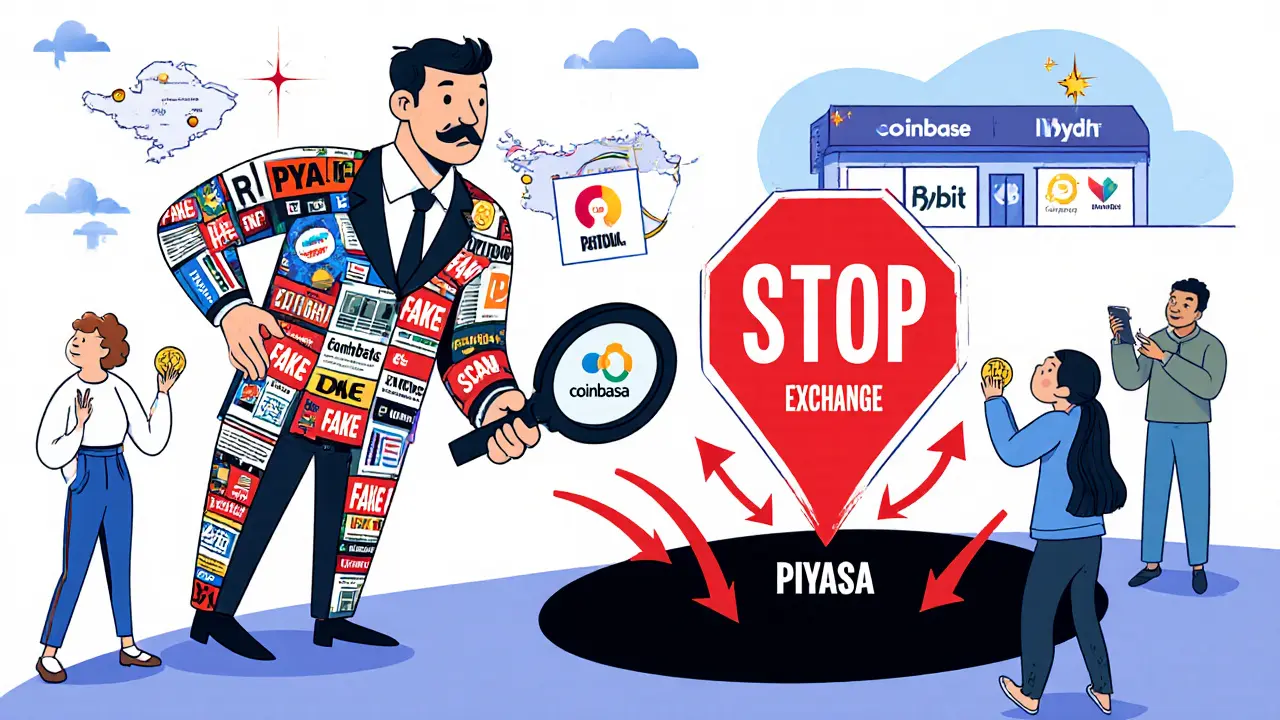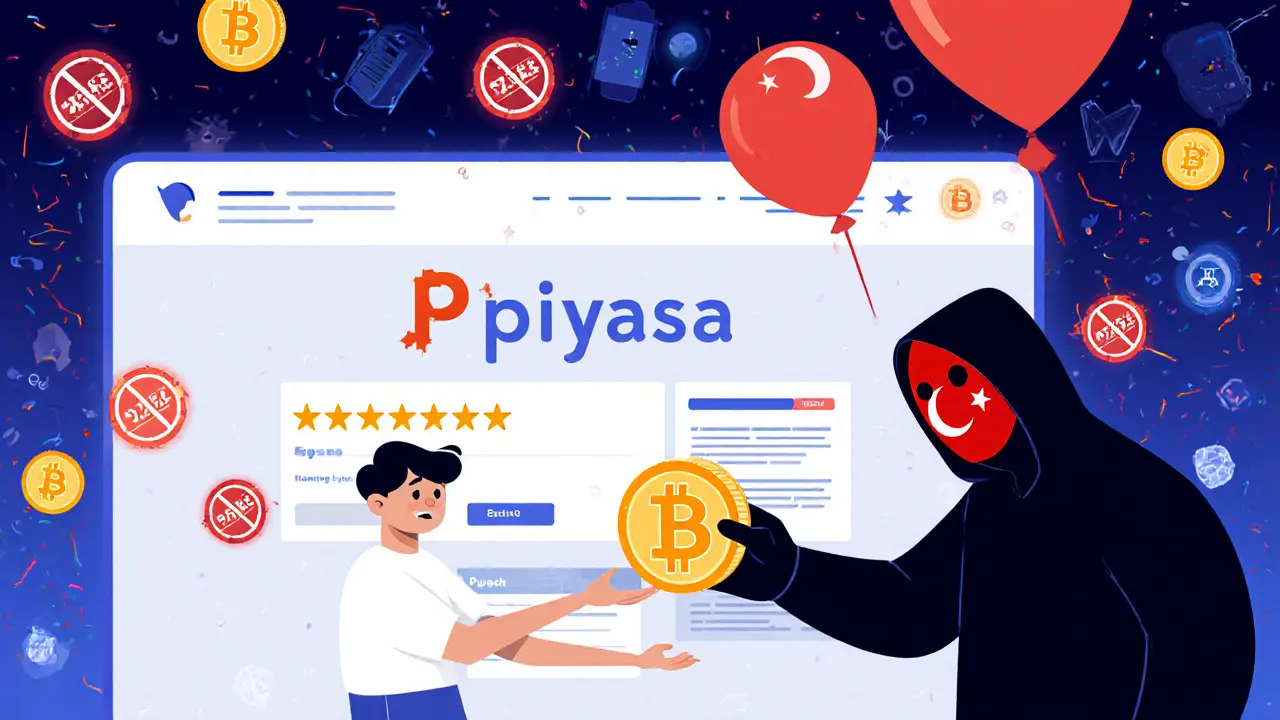Crypto Exchange Legitimacy Checker
Is This Exchange Legitimate?
Check if a crypto exchange is real or a scam using key verification criteria from the article.
Verification Results
There’s no such thing as a legitimate crypto exchange called Piyasa. Not now, not ever. If you’ve seen ads for it, heard about it on social media, or got a message promising high returns through “Piyasa Crypto Exchange,” you’re being targeted by a scam.
The word “Piyasa” isn’t a brand name-it’s Turkish for “market.” Scammers use local language terms like this to trick people into thinking the platform is legitimate in their region. In Turkey, where this word is common, fake exchanges often pop up with names like “Piyasa,” “Pazar,” or “Borsa” to look trustworthy. But if it’s not listed on CoinMarketCap, CoinGecko, or any major exchange ranking, it’s not real.
Why Piyasa Doesn’t Exist
Every reputable crypto exchange-Binance, Kraken, Bybit, Coinbase-has a public record. They’re registered with financial authorities. They publish their company details. They show proof of reserves so you know your funds are actually there. Piyasa has none of that.
Check any of the top 10 exchange lists from NFTEvening, Coinspeaker, FXEmpire, or ChainPlay. Search for “Piyasa” in their 2025 reviews. You won’t find it. Not once. That’s not an oversight. It’s a red flag so loud it should be deafening.
Even the most obscure but real exchanges have at least one regulatory license. Binance holds 38. Crypto.com has 47. Kraken got a full banking charter in Wyoming. Piyasa? No registration. No legal entity. No address. No contact info. Just a website with flashy graphics and fake testimonials.
How Scammers Use Names Like Piyasa
Scammers don’t just pick random names. They study where people are looking for crypto services. Turkey has a large crypto-using population, but strict rules against unlicensed platforms. So scammers create fake exchanges with Turkish-sounding names to trick locals into thinking they’re safe.
Here’s how it works:
- You land on a site called “Piyasa Crypto Exchange.”
- You see “Trusted by 50,000+ Users” and fake 5-star reviews.
- You’re told you can earn 187% APY on your crypto-impossible on any real exchange.
- You deposit your Bitcoin or Ethereum.
- Then, the site disappears. Or you can’t withdraw. Or they demand more fees to “unlock” your funds.
This pattern shows up again and again in Reddit’s r/CryptoScams. In Q3 2025 alone, 217 reports matched this exact setup. Every single one used a localized name. Every single one vanished within six months.
What Real Exchanges Look Like
If you’re looking for a real crypto exchange, here’s what to check:
- Regulation: Does it list its legal entity? Binance is “Binance Markets Limited,” registered in Malta (C 70027). Crypto.com is “Crypto.com Pte. Ltd.” in Singapore (UEN 201830517W). Piyasa? Nothing.
- Proof of Reserves: Real exchanges show real-time audits. You can see on Blockchain Transparency Institute’s dashboard that Binance holds more than 100% of user funds. Piyasa? No dashboard. No proof.
- Trading Volume: Legit platforms have millions in daily volume. Kaiko and CoinMarketCap track this. Piyasa has zero recorded volume. Zero.
- User Reviews: Binance has over 18,000 reviews on Trustpilot with a 4.1 rating. Piyasa has zero authentic reviews. The few “reviews” you find are copied, generic, and posted within hours of each other.
Any exchange that doesn’t meet these four criteria is dangerous. Piyasa fails all of them.

The Bigger Picture: Why Scams Like This Are Rising
According to Chainalysis’ 2025 Crypto Scam Observatory, 72% of fake exchanges shut down within 18 months. 89% manipulate trading data to lure people in. And 63% of non-English named platforms turn out to be scams-especially those targeting Turkish, Russian, or Spanish-speaking users.
The Turkish government banned unlicensed crypto exchanges in October 2025. That didn’t stop scammers. It just made them smarter. Now they use Turkish names to appear local, even though they’re hosted on servers in Eastern Europe or Southeast Asia.
Meanwhile, global regulators are catching up. The Financial Action Task Force now requires exchanges to verify their names and locations. CoinGecko updated its listing rules in November 2025: any exchange must show $500,000 in verified reserves and 90 days of real trading volume to even be considered.
Piyasa doesn’t meet any of these standards. That’s not an accident. It’s proof.
What to Do If You’ve Already Used Piyasa
If you sent crypto to Piyasa:
- Stop sending more money. No matter what they say-“just one more fee to unlock,” “your funds are frozen,” “we need your ID”-it’s a lie.
- Document everything: screenshots, emails, transaction IDs. Even if you can’t recover funds, this helps authorities track the scam.
- Report it. Use the Cryptolegal.uk scam registry. File a report with your local financial regulator. Even if they can’t help you, they can warn others.
- Check your wallet. If you used a hot wallet connected to Piyasa, move any remaining funds to a hardware wallet like Ledger or Trezor immediately.
Recovery is unlikely, but reporting helps prevent others from falling for the same trap.

Safe Alternatives to Piyasa
Stick with exchanges that are listed, regulated, and transparent:
- Binance: Largest by volume. Licenses in 38 countries. Transparent reserves.
- Kraken: First U.S. exchange with a banking charter. Strong security and compliance.
- Bybit: Popular for derivatives. Licensed in France and UAE.
- Coinbase: Fully regulated in the U.S., EU, and UK. Easy for beginners.
All of these have real customer support, real legal teams, and real track records. None of them promise 200% returns.
Final Warning
If it sounds too good to be true, it is. If you can’t find it on CoinMarketCap, it’s not real. If the name sounds like a common word in your language, it’s probably a scam.
Piyasa isn’t a crypto exchange. It’s a digital trap. And it’s not alone. There are hundreds like it-changing names, shifting domains, targeting new regions every month.
Don’t be the next victim. Use only exchanges with a public record. Ask questions. Demand transparency. And if you’re unsure? Don’t deposit a cent.
Is Piyasa Crypto Exchange real?
No, Piyasa Crypto Exchange is not real. It does not appear on any major exchange rankings, has no regulatory licenses, and shows no proof of reserves. The name “Piyasa” is Turkish for “market,” a tactic scammers use to appear local. It is either a scam or a non-existent platform.
Why can’t I find Piyasa on CoinMarketCap or CoinGecko?
Because it doesn’t meet their listing requirements. Both platforms now require verified trading volume, proof of reserves, and regulatory compliance. Piyasa has none of these. Legitimate exchanges are listed. Scams are not.
What should I do if I deposited crypto into Piyasa?
Stop sending more money. Document all transactions and communications. Report the platform to Cryptolegal.uk and your local financial regulator. Move any remaining funds to a hardware wallet. Recovery is unlikely, but reporting helps prevent others from being scammed.
Are there any legitimate crypto exchanges with Turkish names?
No. Legitimate exchanges use clear, registered business names-not common words like “Piyasa” or “Borsa.” Even exchanges serving Turkish users, like Bitci or Paribu, have official legal registrations and are listed on CoinMarketCap. If it uses a generic word as its brand, it’s a red flag.
How can I spot a fake crypto exchange?
Check these five things: 1) Is it listed on CoinMarketCap or CoinGecko? 2) Does it show proof of reserves? 3) Does it have a legal entity and registration number? 4) Are user reviews authentic and numerous? 5) Does it promise guaranteed high returns? If any answer is “no,” walk away.
